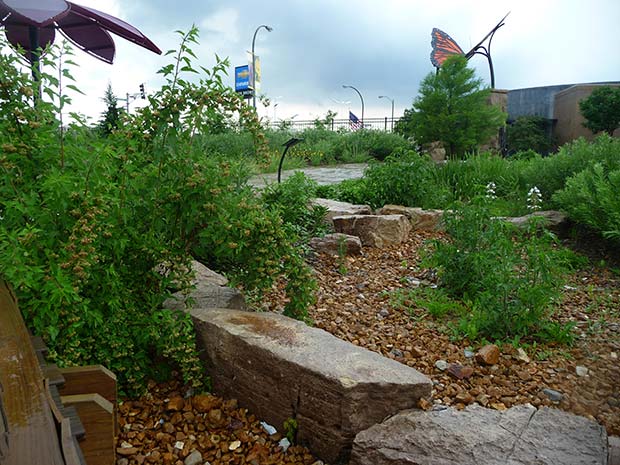Rain can be a valuable resource when managed properly. If not managed properly, storm water runoff can threaten homes, neighborhoods and even people’s lives. If we each do our part in our community and at home—like through rain gardening—we can work to minimize damage caused by urban stormwater runoff and flash flooding.
The best way to start is to manage stormwater as close to where it lands as possible. Rainscaping incorporates features into the landscape that manage stormwater and reduce runoff, such as rain gardens (a planted depression or hole) or bioswales (a planted, gently-sloped shallow ditch–think of a miniature, quick-draining wetland). When vegetated with native plantings, rain gardens and bioswales reduce stormwater runoff and improve water quality by filtering out pollutants through the soil and absorbing water into the plants’ large, deep root systems.
Native plants recommended for rain gardens and bioswales can survive when the soil is wet from heavy rains and when the soil is dry from periods of drought because they have adapted to Missouri’s climate and soil conditions. These rain garden plants also attract desirable wildlife, such as birds, bees, butterflies and dragonflies. Rain gardens do not attract mosquitoes as the water is typically absorbed within 48 hours which is not long enough for mosquitoes to breed.
Think about creating a rain garden at home and educating community leaders about the importance of incorporating rain gardens and bioswales into developments in your community or neighborhood. Come visit our Demo Garden and you can see rain gardening with native grasses, perennials, shrubs and trees. It’s a beautiful place to visit and the interpretive displays around the garden describe the appropriate plants to use and the many rain garden benefits.

Rain Gardening at Home
Directing your downspout into a rain garden or bioswale is a great way to have a beautiful garden plus slow down storm water and filter out pollutants to protect downstream water quality. The native plants in rain gardens and bioswales can provide food and shelter for beneficial wildlife such as birds, bees, butterflies and other important pollinators. Water in rain gardens typically drains within 48 hours.
Rain gardens can also have clay soil which does not dry out quickly so be sure to select plants appropriate for your soil type. The Brightside Demo Garden is full of great examples to help you choose the right plant for the right place.
Don’t worry about mosquitoes – birds, dragonflies and other insects attracted by your native plantings love to eat mosquitoes. Because rain gardens and bioswales drain so quickly, there is not enough time for any mosquitoes to lay and hatch eggs.
SEE IT AT THE DEMO GARDENResources
Consider your soil type – clay or well-drained soil – and be sure to select the right plants for your rain garden depending on how wet the soil will stay. Find the right plants for your soil type in the Grow Native! Native Plant Rain Gardens guide.
To learn more about rainscaping, building a rain garden, and what’s right for your yard or project area, check out the Missouri Botanical Garden’s RainScaping Guide and Shaw Nature Reserve’s Rain Gardening and Storm-Water Management Manual.
Learn what you can do to prevent urban storm water runoff from polluting our streams and rivers.
Use The Green Values Stormwater Toolbox and Stormwater Management Calculator to learn about storm water management practices and compare the performance, costs and benefits of low-impact development to conventional storm water practices.
East-West Gateway Council of Governments explores St. Louis rainscaping projects.
EPA shares Tools, Strategies and Lessons Learned from EPA Green Infrastructure Technical Assistance Projects.